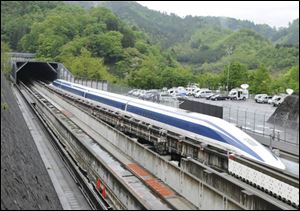
Japan pitches its Maglev Train to Americans
11/18/2013
The Maglev (magnetic levitation) train speeds during a test run on the experimental track in Tsuru, 100km west of Tokyo.
TSURU, Japan — As the world’s fastest train raced through the mountains of central Japan, former Gov. George E. Pataki of New York hoisted his 6-foot-5 frame into the aisle, lifted his hands from his seat and marveled at the smoothness of the ride.
“In the subway I’d need a strap, at least,” Pataki said as the speedometer hit 314 mph and fleeting glimpses of Mount Fuji appeared through the porthole-like windows. “This is amazing. The future.”
Pataki and a group of other retired American politicians and public figures were in Japan on Saturday for a special test ride of the train, which uses a technology called magnetic levitation, or maglev, to cruise at more than twice the 150 mph top speed of Amtrak’s Acela, the fastest train in the United States. They are trying to bring the technology to the United States, to speed up travel times and ease congestion in the crowded northeast corridor between New York and Washington.
And to sweeten the deal, the Japanese have offered to foot the bill for part of the construction — an amount that could reach billions.
That is where Pataki and the other dignitaries riding the train Saturday, including former Senate Majority Leader Tom Daschle, former Gov. Edward G. Rendell of Pennsylvania and former Transportation Secretary Mary Peters, enter the picture.
Along with former Gov. Christine Todd Whitman of New Jersey, who could not make the trip, they are members of the advisory board of the Northeast Maglev, a privately held, Washington-based company that wants to build a line from Washington to New York using the Japanese technology.
Trains would cover the 230-mile distance in one hour, compared with 2 hours and 45 minutes for the Acela. Additional stations would be included at Newark Liberty International Airport; Philadelphia; Philadelphia International Airport; Wilmington, Del.; Baltimore; and Baltimore Washington International Airport.
Promoters of the plan say the faster travel time would increase the productivity of workers in the Northeast, as well as relieve pressure on crowded airports and crumbling highways.
Yet in the American Northeast, maglev trains are only the latest in a series of proposals to upgrade service linking Washington, New York and, in some cases, Boston. Few of these plans have left the station.
At a time when governments are wrestling with growing debts, expensive railway projects are a tough sell. A planned high-speed railway in California faces delays over financing and wrangling over the route. Protesters in Britain are battling their government’s plan to build a high-speed line north from London.